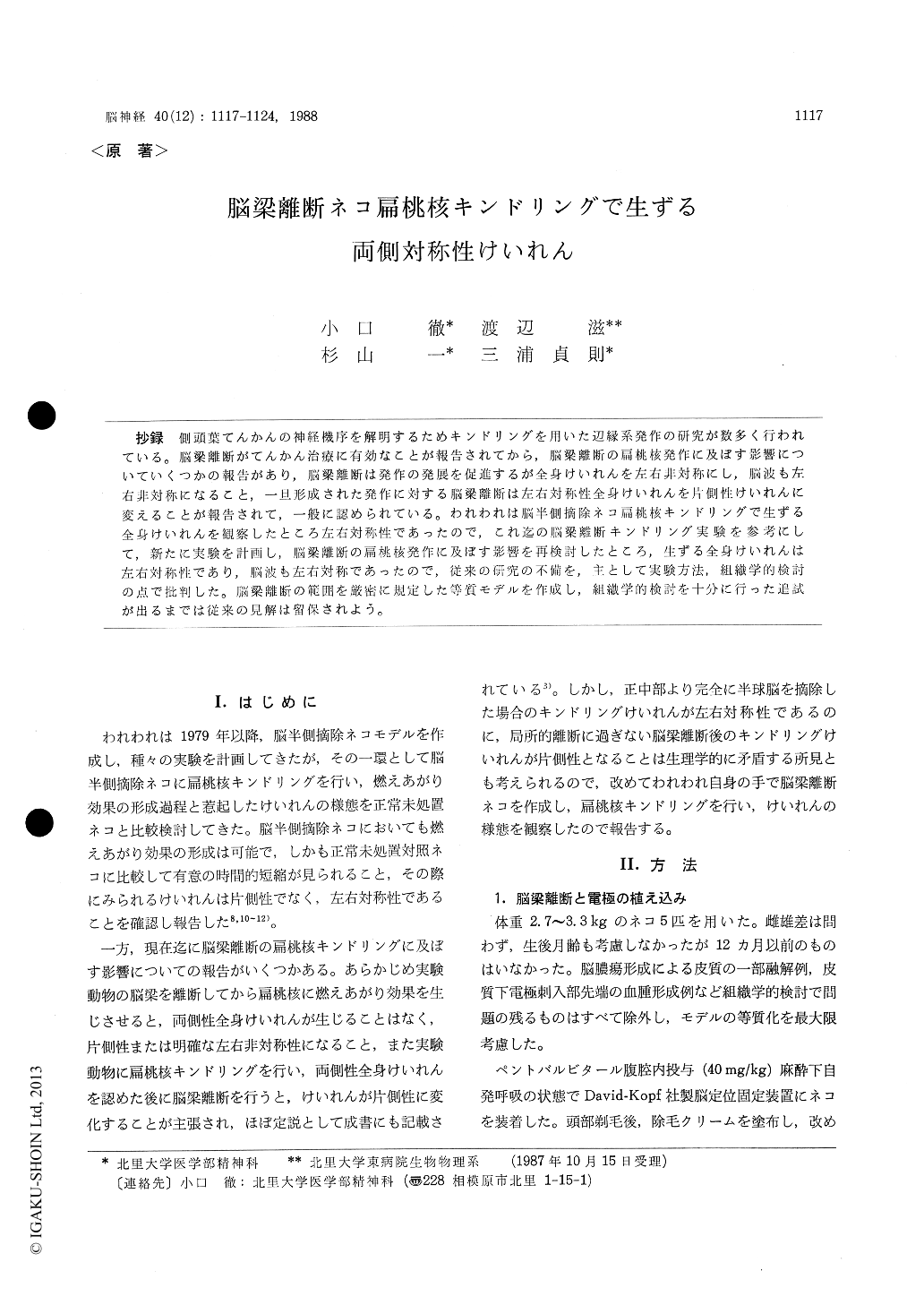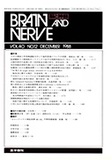Japanese
English
- 有料閲覧
- Abstract 文献概要
- 1ページ目 Look Inside
抄録 側頭葉てんかんの神経機序を解明するためキンドリングを用いた辺縁系発作の研究が数多く行われている。脳梁離断がてんかん治療に有効なことが報告されてから,脳梁離断の扁桃核発作に及ぼす影響についていくつかの報告があり,脳梁離断は発作の発展を促進するが全身けいれんを左右非対称にし,脳波も左右非対称になること,一旦形成された発作に対する脳梁離断は左右対称性全身けいれんを片側性けいれんに変えることが報告されて,一般に認められている。われわれは脳半側摘除ネコ扁桃核キンドリングで生ずる全身けいれんを観察したところ左右対称性であったので,これ迄の脳梁離断キンドリング実験を参考にして,新たに実験を計画し,脳梁離断の扁桃核発作に及ぼす影響を再検討したところ,生ずる全身けいれんは左右対称性であり,脳波も左右対称であったので,従来の研究の不備を,主として実験方法,組織学的検討の点で批判した。脳梁離断の範囲を厳密に規定した等質モデルを作成し,組織学的検討を十分に行った追試が出るまでは従来の見解は留保されよう。
Previous studies have shown that the corpus callosum is involved in the propagation of epi-leptic discharge between two hemispheric areas of the brain. It is generally admitted that inte-grity of the corpus callosum is necessary for the bilateral clinical seizure manifestation. After inves-tigating the role of the forebrain commissures in the development of the kindled amygdaloid seizure in cats, some authors insist that following the bisection of the corpus callosum, ordinary bilateral amygdaloid kindling convulsion becomes into hemi-convulsion and its EEG becomes also unequal ; the kindling side showed clear seizure pattern, the other side remained normal.
In our former experiment, we intended to com-pare the half-brainloss hemispherectomized cats with the intact ones on the time latency for the completion of the amygdaloid kindling effect as well as on the developmental change of the clini-cal seizure manifestation. The time latency of the operated cats was significantly shorter than that observed in the control cats and all the examined cats always showed typically bilateral symmetrical convulsion from the first kindling.
Our results are contradictory to those of the split brain experiments whose cat's brain is only locally bisected. We reviewed the related papers and knew that not a few authors omitted to men-tion the operation technique and did not give the histological evidence of cutting. So we tried to contrive the best split brain cutting after studying previous authors' operation techniques.
Ten cats weighing from 2.7 to 3.3 kg aged above 12 months were used. Among them, 5 cats were for normal controls. Under the pentobarbital anesthesia, a sterile osteoplastic craniotomy was made. By aid of the surgical microscope, the corpus callosum was bisected at the midline under direct vision. Electrodes were implanted in the right dorsal hippobampus, the bilateral nuclei amygda-loideus lateralis, the right midbrain reticular forma-tion and the right cortex. One month followingthe operation, the cats were electrically stimulated daily at the after-discharge threshold intensity. The time latency for the completion of the kindl-ing effect of the corpus callosum cut cats (16.6± 5.7; mean±SD) was a little shorter than that observed in the control animals (21.0±5.5). The after-discharge threshold was from 150 to 500 1.A, the generalized seizure triggering threshold from 50 to 500 μA and the after-discharge duration in the final stage of seizure was 84.0±17.1 sec. All the results were, however, not significantly dif-ferent from those of the control animals. With regard to the development of the clinical seizuremanifestation, all the examined cats showed typi-cally bilateral facial twitching and perfectly syn-chronous clonic-tonic bilateral convulsions. EEG on both side of them also showed bilateral spike bursts.
On the basis of our data, the midline bisection of the corpus callosum never modifies the pattern and duration of amygdaloid kindled generalized convulsion. We suggest that the limbic brainstem connection may play the important role in the seizure propagation.

Copyright © 1988, Igaku-Shoin Ltd. All rights reserved.


